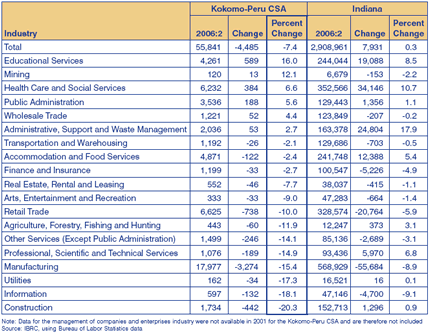The Kokomo-Peru CSA
This article is the third of seven that will highlight each of Indiana's combined statistical areas (CSAs). CSAs are groupings of predefined metropolitan (metro) and/or micropolitan (micro) areas that, as the title suggests, combine these areas to “represent larger regions and reflect broader social and economic interactions.” (1)
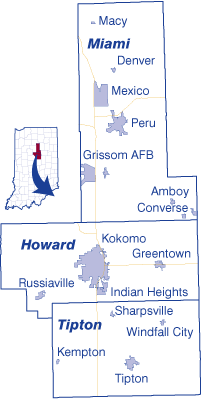
Howard, Miami and Tipton counties make up the Kokomo-Peru CSA, which is the smallest CSA in Indiana. Accounting for only 2.2 percent of Indiana's population in 2005, the area has just under 137,000 residents. In fact, only 10 of the 121 CSAs nationwide are smaller in population than the Kokomo-Peru CSA. This particular Indiana CSA was among the 14 percent of all CSAs nationwide to experience an overall loss in population from July 2000 to 2005.
Of the 10 largest cities and towns in the combined statistical area, only Kokomo and Peru have more than 10,000 residents. Denver, the 10th largest town in the CSA, has only 521 residents, and 47.7 percent of all residents of the CSA live in smaller towns or other areas (see Figure 1).
Figure 1: Population Distribution in the Kokomo-Peru CSA, 2005

Jobs
The Kokomo-Peru CSA has seen fairly steady declines in jobs from 2001:2 to 2006:2 (other than an increase of 775 jobs in 2005), with total losses for the area at 4,485. In contrast, the state has been adding jobs since 2003 (see Figure 2). In more comparable percentage terms, the decline in jobs in the Kokomo-Peru CSA was -7.4 percent compared to a 0.3 percent increase in Indiana. Manufacturing did the most damage in the CSA with more than 3,200 jobs lost since the second quarter of 2001. Even after these losses are figured in, manufacturing comprised 32.2 percent of jobs in the CSA, significantly higher than the state's 19.6 percent.
Figure 2: Jobs in the Kokomo-Peru CSA and Indiana, 2001:2 to 2006:2
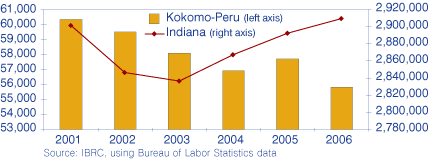
The largest gains in the Kokomo-Peru CSA were in education and health care and social services, with increases of about 590 jobs and 384 jobs, respectively (see Table 1). With these mild additions being the largest the combined statistical area saw, it is not surprising to see such drastic declines over the past five years.
Table 1: Jobs in the Kokomo-Peru CSA and Indiana by Industry, 2001:2 to 2006:2
There were eight companies in the Kokomo-Peru CSA that employed at least 500 people, seven of which are located in Howard County. The largest of these companies was Delphi Electronics, a manufacturer of semiconductors and related devices (see Table 2).
Table 2: Largest Companies in the Kokomo-Peru CSA
Wages
While the job market was not overly appealing from 2001 to 2006 in the Kokomo-Peru CSA, average weekly wages were at least somewhat encouraging. For total covered employment, the CSA consistently paid at least $110 more per week in all five years.
At the individual industry level, the region's manufacturing firms paid an average of $515 more per week than did Indiana firms in the second quarter of 2006. The other two industries where the Kokomo-Peru CSA paid higher wages were in agriculture, forestry, fishing and hunting and transportation and warehousing (see Figure 3). The downside is that each of these three industries experienced job losses during the last five years.
Figure 3: Average Weekly Wages by Industry, 2006:2
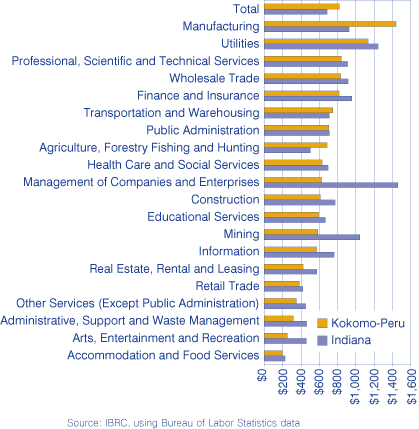
Commuting
Around 63,100 workers lived in the Kokomo-Peru CSA, according to Census 2000. Of those, 75.5 percent live and work in the same county within the CSA, and another 10.6 percent travel to other counties within the CSA (see Figure 4). As for those workers leaving the combined statistical area, 13.6 percent travel to other counties within Indiana, meaning less than 1 percent leave the state (which is expected, given the central location of the CSA within Indiana).
Figure 4: Commuting Patterns in the Kokomo-Peru CSA, 2000
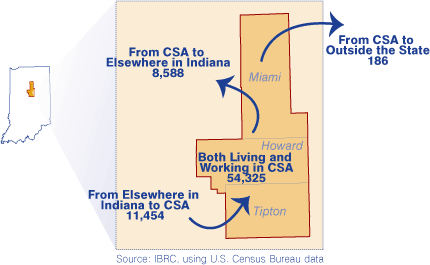
Notes
- U.S. Office of Management and Budget, available at www.whitehouse.gov/omb/
Molly Manns, Research Associate
Indiana Business Research Center, Kelley School of Business, Indiana University

